Journal article
Jan 11 2017
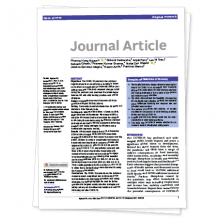
The association of a large-scale television campaign with exclusive breastfeeding prevalence in Viet Nam (Nguyen TT., 2017. American Journal of Public Health)
Alive & Thrive (A&T) used qualitative research methods to examine the association between exposure to breastfeeding television spots and exclusive breastfeeding (EBF) between 2011 and 2014 in Viet Nam.
Journal article
Oct 25 2016

Impacts on breastfeeding practices of at-scale strategies that combine intensive interpersonal counseling, mass media, and community mobilization: results of cluster-randomized program evaluations in Bangladesh and Viet Nam (Menon P., 2016. PLOS Med)
In Bangladesh and Viet Nam between 2009–2014, Alive & Thrive (A&T) worked to improve breastfeeding practices through intensified interpersonal counseling (IPC), mass media (MM), and community mobilization (CM) intervention components delivered at scale in the context of policy advocacy (P
Brief
May 23 2016
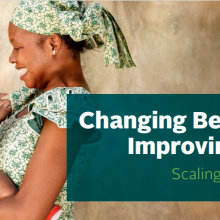
Alive & Thrive: Changing behaviors, improving lives
Describes the Alive & Thrive initiative by outlining how and why we began, what we’ve achieved and how we’ve evolved today. Also illustrates the four component framework that we use to scale up nutrition.
Brief
Apr 13 2016
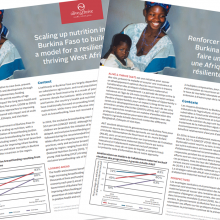
Scaling up nutrition in Burkina Faso to build a model for a resilient, thriving West Africa
This brief describes the Alive & Thrive (A&T) approach and four component framework for scaling up nutrition in Burkina Faso.
Brief
Feb 19 2016
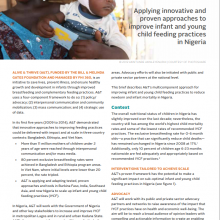
Applying innovative and proven approaches to improve infant and young child feeding practices in Nigeria
The overall nutritional status of children in Nigeria has slightly improved over the last decade; nevertheless, the country still has among the world’s highest child mortality rates and some of the lowest rates of recommended IYCF practices.
Guide/Manual
Dec 28 2015
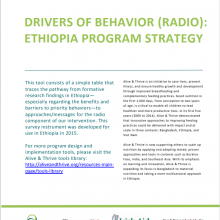
Drivers of behavior (radio): Ethiopia program strategy
This tool consists of a simple table that traces the pathway from formative research findings in Ethiopia— especially regarding the benefits and barriers to priority behaviors—to approaches/messages for the radio component of our intervention.

